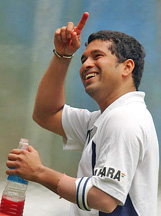COACHING
Cricket and the tennis elbow - Treatment
How is an acute tennis elbow managed and treated?In most cases, avoidance of any motion that is painful will suffice. The immediate treatment could be a combination of ice and anti-inflammatory ointment. Along with this, physiotherapy treatment such as ultrasound and interferential therapy is important. It would be advisable to place a splint that will immobilize the wrist and keep it in a neutral position. Wrist immobilisers, like a cock-up splint or a plaster cast, relieve the tension on the wrist extensors.
Crepe-bandaging or immobilization of the elbow itself need not be done.
First aid: Besides the described treatment given by the physiotherapist, I would recommend the application of ice every hour, for a period of 10-15 minutes atleast four to five times a day and wrapping of a wet bandage around the forearm and elbow for 10 minutes after icing. This should be done until the pain lessens.Anti-inflammatory ointments could also be applied two to three times a day .
As the acute condition subsides, the player could start stretching, strengthening and toning exercises of the wrist. However, he should resume playing cricket until the physio gives him a green signal.
FOLLOW-UP CARE
As the local swelling shrinks, an inelastic scar tissue is formed. Stretching exercises are therefore of great value, as they help nullify the likely consequences of an inelastic scar tissue.
Stretching exercises of the forearm:
The injured player should face a wall, keeping the dorsum (back) of the hand, flat on the wall. He should keep the elbow locked. When he leans forward, the wrist is forced into 90% flexion. Stretching with a bat: Grasp the centre of the handle and slowly raise the bat almost parallel to the ground. Then bring it down gradually. Repeat this 10 times.
Stretching with the back swing: Assume the correct stance. Grip the handle and use the back swing motion in a full follow-through with a bat.
Stretching from the fist: Turn the hand inwards, so that the thumb points downwards. Then stretch the elbow and push the arm outwards. Angle the hand at the wrist far enough outwards, so that tension is felt in the muscles of the lower arm (repeat this exercise five times, each time for 10-15 seconds)
STRENGTHENING:
Resistive exercises are used to re-strengthen the forearm and wrist extensors. These exercises can be performed with the help of weights of two kgs. The forearm is supported on a block or over the couch and full range of motion is attempted. Therabands(????) can be used as a power band extension exercisor. It can be performed where one end of the band is placed beneath the foot and the other end gripped. The wrist extension movement can be performed.
OPENING POSITION:
Place the forearm on a table surface, while keeping the wrist at the table's edge. The hand should freely move up and down. FLEXION EXERCISES: The palm should face downwards as you hold the bat at right angles in front of the body. The bat is held in such a manner that it's weight is evenly distributed across the palm. Now turn the hand in both directions, i.e. left and right.
It is important to reduce the stress from exacerbating activities and the use of counterforce bracing is effective while playing. The counterforce brace consists of a tight strap that is placed around the upper forearm to create lateral pressure when a bat is gripped. The aim is to redirect and disperse overload to the healthy tissue or the band itself, and in so doing, reduce painful inhibition and permit a more forceful contraction.
SPORTS ERGONOMICS

Sachin Tendulkar and his tennis elbow.
Ergonomics plays an important part in the
management of this condition. Enlarging the grip of
the bat's handle is important in most cases.
The correct grip-size can be calculated by measuring the distance from the tip of the ring-finger to the bottom lateral crease of the palm. The figure obtained represents the circumference of the bat handle. Placing a thick piece of sponge around a handle can also help enlarge the grip and reduce the shock that travels from the handle to the hand. In some cases, a grip that is too large may also pose a problem, so to assess whether the grip-size is a relevant feature, ask the person to grip a thin handle and then a large one, to find out which one of the two causes pain.
WEIGHT OF THE BAT: A heavier bat has more momentum and will place greater strain on the forearm, which ultimately causes a TENNIS ELBOW.Hence, it is preferable to use a bat that is relatively lighter. It will reduce the chances of a tennis elbow in the long run.
The correct grip-size can be calculated by measuring the distance from the tip of the ring-finger to the bottom lateral crease of the palm. The figure obtained represents the circumference of the bat handle. Placing a thick piece of sponge around a handle can also help enlarge the grip and reduce the shock that travels from the handle to the hand. In some cases, a grip that is too large may also pose a problem, so to assess whether the grip-size is a relevant feature, ask the person to grip a thin handle and then a large one, to find out which one of the two causes pain.
WEIGHT OF THE BAT: A heavier bat has more momentum and will place greater strain on the forearm, which ultimately causes a TENNIS ELBOW.Hence, it is preferable to use a bat that is relatively lighter. It will reduce the chances of a tennis elbow in the long run.